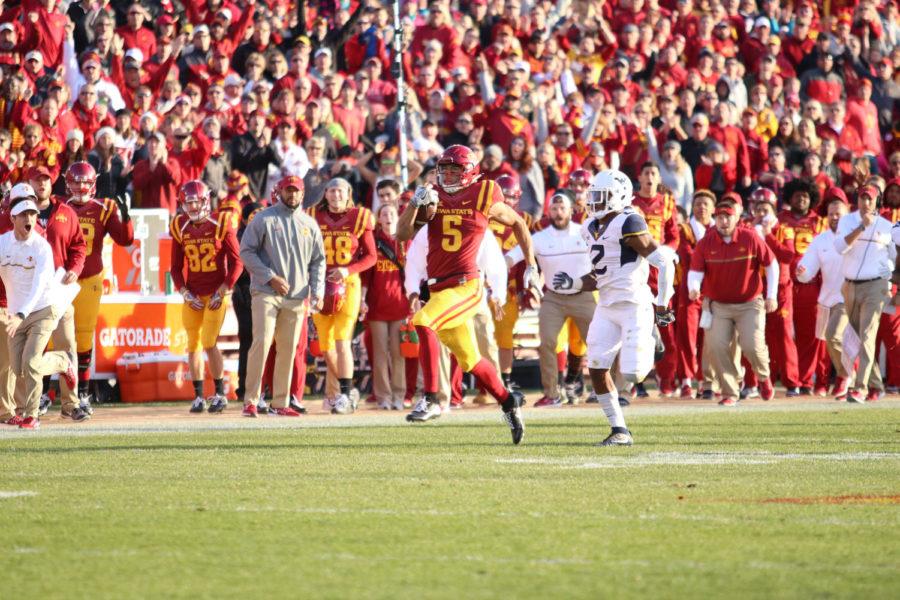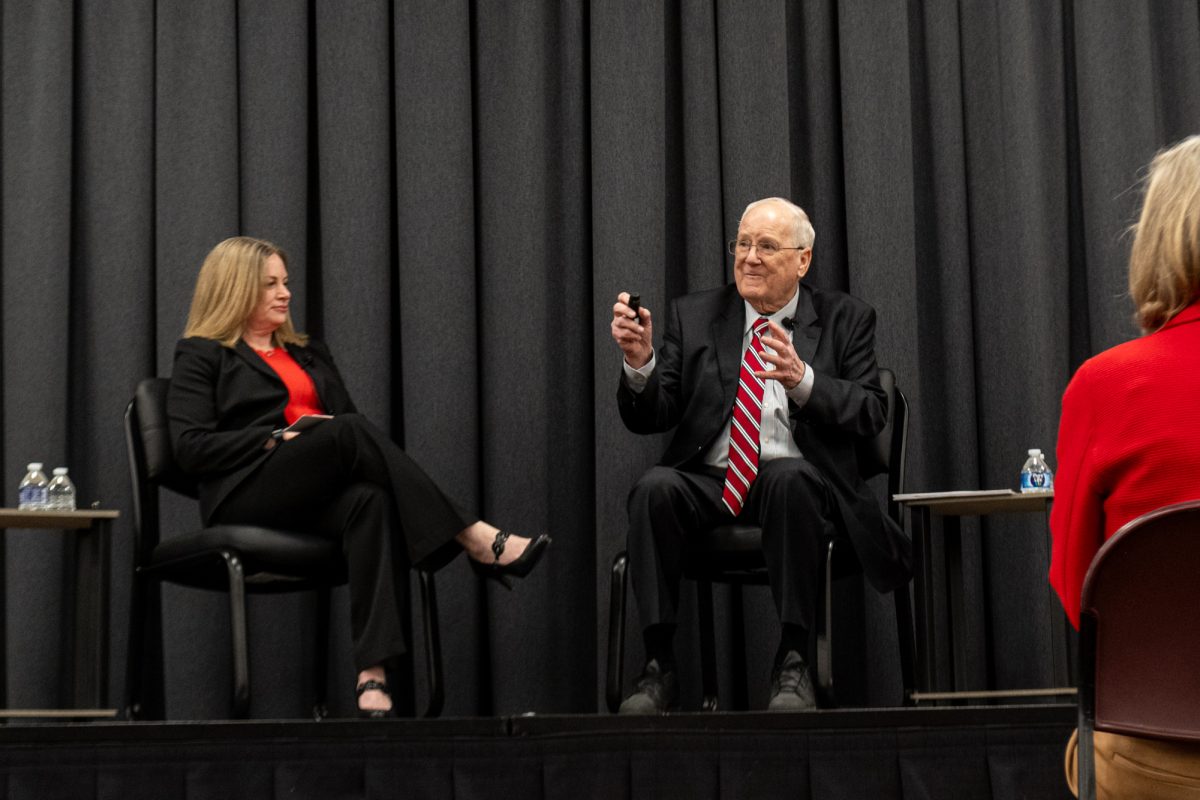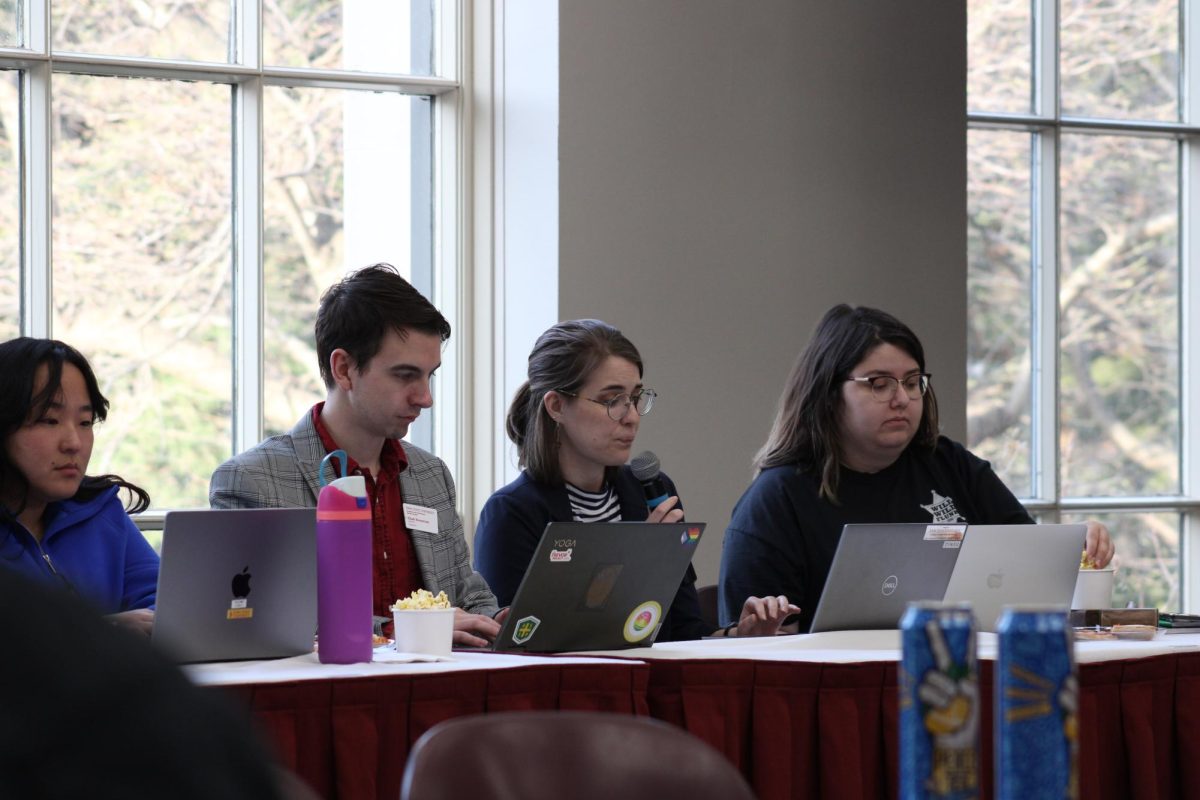The hidden benefits: Scholarships provide more than monetary benefit, but controversy rages
Chris Jorgensen/Iowa State Daily
Iowa State receiver Allen Lazard broke free from the defense after a catch for a big gain during the first half against West Virginia.
April 23, 2017
There has been plenty of controversy surrounding student-athletes and benefits. It has been a long debate on whether these athletes should get paid beyond their scholarships and benefits in college.
Studies show that less than 1 percent of high school athletes will go on to earn a scholarship in college. When looking at a particular sport, such as football, there are up to 85 scholarships for each team. At least 300,000 athletes across the country are fighting for one of these spots.
Former Iowa State running back Jeff Woody knows what it’s like to have to fight for a scholarship. After one year of being a walk-on player, then-coach Paul Rhoads rewarded him.
“Initially I was looking to get the most available time on the playing field,” Woody said. “Getting my education paid for along with the other benefits were just a by-product of my effort.”
The mind of a walk-on can be different than other college football players. There can be a mentality that everyone else is better than them, because they start with nothing. To get to their level, the walk-on must conquer that mental roadblock and show more effort on the field.
Nothing is ever guaranteed.
Though it doesn’t get much easier for any athlete with a scholarship, not having to fight for a spot certainly makes things easier. Receiver star Allen Lazard, ranked as a four-star recruit when he graduated Urbandale High School, has been on scholarship since he committed to Iowa State around four years ago.
His older brother, Anthony, who also played for Iowa State, played without being on scholarship.
“I’m very grateful for what I’ve been given in life,” Allen Lazard said. “I watched my brother struggle through college, working as well as playing football. Having a scholarship makes a world of a difference.”
Players on the team either have a full-ride scholarship or no financial help at all. Most athletes receive scholarships when they sign with the team, but there are some exceptions for outstanding walk-ons.
Within the last five years, the NCAA revised its scholarship benefits, allowing athletes to be under scholarship for four years. These scholarships also include cost of attendance in addition to the other benefits student-athletes receive.
“As student-athletes, we give the university a multitude of great avenues to make money,” Kory Kodanko, senior on the football team, said. “In return, the university helps make sure we succeed both on and off the field.”
Being a member of a sports team in college is similar to that of working a full-time job. For a football player, a typical day consists of early lifting, classes and team workouts, followed by time for homework or studying. To keep a balance between the two, athletes are given academic advisers, who help plan out academic schedules.
In addition to having extra advisers, the athletic department has various workshops that focus on future careers, such as résumé-building seminars.
“If you ask any coach at Iowa State, they will put an emphasis on graduation,” Kodanko said. “They want to see you succeed in life beyond sports as well.”
Kodanko has been playing under scholarship, and when he graduates, he will be debt free. For him, it makes a huge difference not only economically, being an out-of-state student, but mentally as well.
“Knowing I won’t start off in the real world with debt on my shoulder is huge,” Kodanko said. “Personally it allows me to clear my conscience and put myself in a better state of mind for success.”
There are other benefits these athletes have received in addition to “free” tuition, such as tutoring services. Tutors help athletes when needed and help maintain the balance between the field and the classroom.
With their help, Woody graduated with a bachelor’s and master’s degree while accruing no student debt.
“A wise man once told me that there are very few kinds of good debt, education being the best one,” Woody said. “It’s quite rare to graduate with two degrees and no debt, a lot of avoided stress.”
In addition to providing academic support, the athletic department also focuses on post-graduation aspirations. In the last year, the department brought in previous football alumni to assist current players in potential careers after college. Lazard will either go to the NFL or pursue another career after this upcoming football season.
“I’m currently working on getting a degree in communication, which will give me many options,” Lazard said. “I also could end up coaching or working with kids. I haven’t thought about it that much.”
For Woody, playing in the NFL wasn’t on his radar while playing in college. In addition to polishing himself physically and mentally on the field, he also honed in on a potential career off the field.
Some of the skills Woody gained included an increased work ethic, learning the importance of team building and gaining an emphasis on leadership. These traits, combined with the educational base he gained at Iowa State, have helped him succeed after college.
A bigger piece of the pie
Despite receiving all these benefits, there are still some ideas that could be implemented that would affect all collegiate football players.
“I think that some sort of concussion insurance would be beneficial,” Lazard said. “These injuries can completely derail a player’s career, sometimes before it even begins.”
This type of insurance would come more into play for seniors or any player who is planning on entering the professional league. The increased emphasis and technology regarding concussions has led to more players being diagnosed than in the past.
Woody has a different thought process when it comes to potential improvements for players.
“What would be nice is if football players got a little more,” Woody said. “We help generate a good amount of revenue for the football program and it’d just be nice to get a bigger piece of that pie.”
An average full ride scholarship is worth between $60,000 and $65,000, Athletic Director Jamie Pollard said. Most full rides are a combination of both tuition and cost of attendance. Included in those costs are health care, travel expenses, strength and conditioning, academic services, among others.
If taken into consideration, these costs alone would equal more than what college athletes would receive if they were paid. Issues like paying for all these costs in addition to athletes getting taxed for their income would also occur if they were to be paid.
“What these athletes don’t quite realize is how much they’re already receiving,” Pollard said. “It just wouldn’t be feasible to actually pay athletes. Too many issues would surface.”
In terms of numbers, athletes receive about $600 if they live on campus. That money goes primarily toward rent and food each month. Though it may not cover the costs entirely, it certainly helps and takes some financial stress off the athletes.
Whether collegiate athletes will ever get paid in the future remains in question. Despite not being salaried, collegiate football athletes receive many benefits. These perks of being an athlete can be converted to cash values, but theycan vary for each individual.
“I’m very thankful for having some of the things I’ve been given,” Lazard said. “As I get older I begin to understand how helpful everyone has been and how they want me to succeed after college.”






